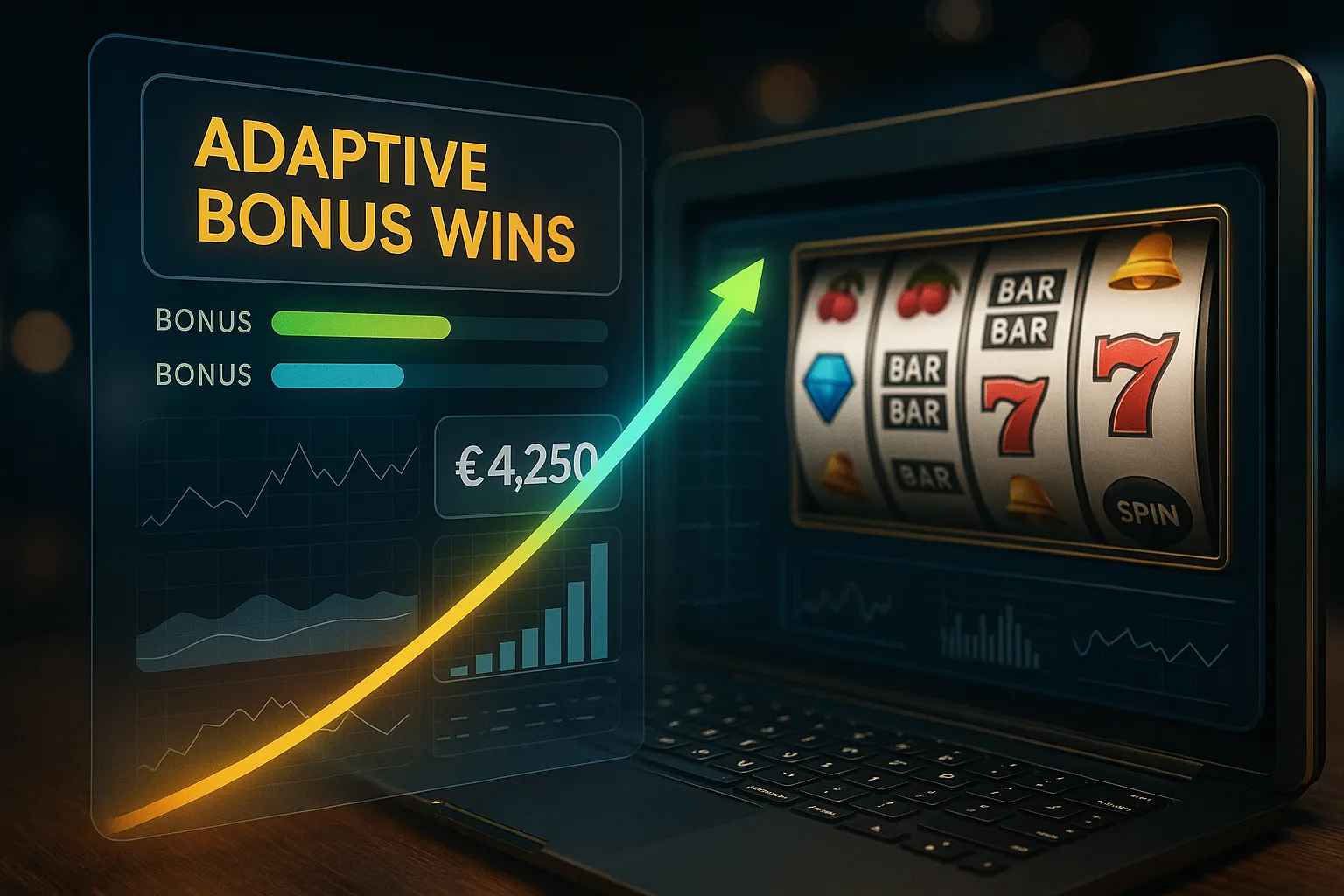Understanding casino bonuses used to be simple: you took a welcome offer, met a fixed wagering requirement, and either cleared it or didn’t. But bonus mechanics have evolved alongside data analytics, AI-driven personalization, and regulatory shifts. One of the most interesting innovations is the concept of adaptive bonus wins—a dynamic way bonuses are structured, released, and even scaled based on player behavior, real-time risk models, and game performance. In this guide I’ll unpack what adaptive bonus wins are, how they work under the hood, why they’re appearing more often, and what savvy players (and operators) need to consider.
Defining Adaptive Bonus Wins
Adaptive bonus wins are variable bonus outcomes (cash, free spins, chips, loyalty multipliers, prize drops, missions, cashback percentages, or tier boosts) whose value, release schedule, or unlock conditions adjust dynamically in response to live or recent player data. Instead of a static “Deposit £50 get £50,” an adaptive system might start you at a modest free spin bundle, recognize a pattern in your session length or volatility preference, then escalate into tailored mission bonuses or incremental win multipliers as you achieve certain behavioral milestones. The “win” component refers not just to the prize you earn inside a special feature but the bonus expectancy you can realize over a session or promotion lifecycle.
In more competitive segments—especially alternative licensing spheres such as UK casinos not on gamstop—adaptive bonus engines are sometimes deployed both to differentiate retention funnels and to manage responsible play thresholds.
How Adaptive Systems Decide What You Get
At the core is a rules-and-model stack. Operators (or third-party promo platforms) ingest telemetry: deposit cadence, average bet size, RTP exposure, time-on-site, session fragmentation, game category diversity, bonus abuse flags, regulatory status, prior opt-outs, and self-exclusion proximity markers. A decision layer then maps you into a dynamic bonus state.
Input Signals
Engagement Metrics: Rolling average spins per session, session frequency per 24h window, dwell time, latency between deposits.
Risk & Compliance Metrics: Geo compliance flags, velocity of withdrawals, chargeback probability heuristics, self-exclusion signals, affordability indicators.
Economics: The operator’s real-time margin from selected games (e.g., high-volatility slots vs. stable table games) and exposure balancing across progressive jackpots.
Game Graph Preferences: Clustering your play into volatility buckets (low, medium, high) and theme clusters (myth, fruit, megaways, crash, live dealer).
These signals feed a rules engine that can say, for example: “Player fits moderate-latency deposit pattern, enjoys feature-rich high-volatility slots, risk score low, entitlement budget remains 73% for this lifecycle segment: escalate to Stage 2 mission with a 35% win booster cap, release half now and half on mission completion.”
Dynamic Prize Curves
Instead of a static reward table, the system maintains curve families—mathematical functions mapping engagement stage to expected bonus value. The curve chosen can flatten (for a high-risk profile) or steepen (for a high-value but responsible, low-risk profile). Sometimes it uses step functions: Stage 1 (try), Stage 2 (expand), Stage 3 (retain), Stage 4 (reactivate). Each stage can redefine your potential “adaptive win” ceiling.
Examples of Adaptive Bonus Wins in Practice
Imagine you log in midweek after a 10-day hiatus. The system detects reactivation potential:
-
Phase 1: 10 free spins at modest volatility to re-familiarize you.
-
Trigger: If you convert at least 30% of spins into feature entries or stay ≥8 minutes, escalate.
-
Phase 2: Unlock a “precision cashback” of 8% losses on qualifying slots, but only up to a dynamic cap computed from your average historical net win volatility.
-
Mission Layer: Achieve three distinct slot sessions (different providers) to “stabilize variety score,” releasing a progressive win multiplier token (e.g., 1.1× applied to net wins from the next feature round, capped).
Your “adaptive bonus win” is not just the immediate freebies but the cumulative yield potential orchestrated in real time.
Another scenario: A steady player exhibits reduced bankroll endurance due to high-volatility game selection. The system may reduce absolute bonus values while improving transparency—switching from large, high-wagering match offers to smaller frictionless “low-wager booster” wins (like 3× wagering on a small locked cash drop) to lower churn risk and overspending.
Why Operators Use Adaptive Bonus Frameworks
Yield Optimization
Static bonuses create inefficient spend—over-rewarding low-lifetime-value segments or under-incentivizing potential VIP transitions. Adaptive curves align cost-of-entitlement with predicted net lifetime value while smoothing margin volatility.
Responsible Play & Regulatory Pressure
Markets influenced by evolving oversight (affordability checks, deposit limits, advertising scrutiny) push operators to personalize safely. Adaptive systems can throttle or simplify bonuses when risk indicators rise—e.g., converting a complex multi-tier mission into a transparent daily loss-limit cashback with real-time running tallies.
Competitive Differentiation
In saturated environments the promotional UX itself becomes product. Presenting evolving “micro-wins” (e.g., unlocking contextual mini-jackpots or session-based multipliers) increases perceived dynamism without simply inflating raw bonus cost.
Player Advantages—If You Understand the Mechanics
Adaptive bonus wins can work for an informed player:
Tailored Volatility Fit: If you gravitate to high-volatility slots, the system may structure staged boosts to smooth variance (e.g., conditional mini-cashbacks after dead streaks).
Lower Hidden Friction: Adaptive reductions in wagering multipliers on smaller dynamic rewards can produce higher effective conversion rates than chasing a giant static bonus with 35× wagering.
Mission Transparency: Some interfaces now surface progress bars that recalc in real time as the system adjusts thresholds, giving you a better ROI forecast.
The flip side: Without awareness you might chase escalating tiers that elongate exposure. Not every “next adaptive win” is cost-effective if it requires disproportionate wagering to unlock the marginal increment.
Common Misconceptions
“Adaptive Means Unfair”
The adaptation is usually rule-bound and auditable internally. Where fairness issues emerge is lack of disclosure clarity. Operators should present: (a) current tier, (b) unlock delta (e.g., £X more real-money wagering or N more unique game sessions), (c) expected reward range, and (d) updated wagering requirement (if it changes).
“It’s Just Gamification Rebranded”
Gamification adds narrative layers (badges, levels). Adaptivity targets economic calibration plus responsible gating. They overlap, but adaptive bonus wins are data-driven value modulation, not just cosmetics.
“Adaptive Always Increases Rewards”
Sometimes it de-escalates to prevent risky escalation patterns. A smaller but instantly withdrawable reward can be a downward adaptive adjustment prioritizing sustainable engagement.
Under the Hood—Technical & Data Considerations
Real-Time Event Stream Processing
Modern platforms ingest spin events, bet outcomes, deposit webhooks, AML flags. A rules engine (e.g., streaming CEP—Complex Event Processing) updates your segmentation every few seconds, enabling “soft refresh” of the bonus widget mid-session.
Budget Guardrails
An entitlement budget per cohort (say per 24 hours) ensures aggregate promotional liability stays within plan. The system may temporarily suppress high-value adaptive wins near budget exhaustion, substituting experiential perks (exclusive room access, personalization skin themes) that cost less cash.
Fraud & Abuse Mitigation
Bonus hunters attempt pattern exploitation (e.g., oscillating bet sizes to trigger loss-recovery boosts). Adaptive detectors run anomaly scoring (z-scores, clustering drift) and can freeze progression or require an additional KYC step before releasing a pending adaptive win.
Evaluating Adaptive Bonus Value as a Player
To assess whether pursuing the next adaptive tier is rational, approximate Expected Convertible Value (ECV):
ECV = (Advertised Bonus Value × Prob(Full Clearance) × (1 – House Edge × Avg Wagering Volume)) – Incremental Cost of Unlock
If the unlock requires extra wagering where your incremental expected loss (house edge × additional turnover) exceeds the incremental adaptive bonus value (net of wagering friction), it’s mathematically negative EV. Savvy players track session-level turnover and compare incremental missions; sometimes stopping before a new adaptive mission resets is optimal.
Ethical & Regulatory Dimensions
Adaptive personalization walks a fine line. Best practice dictates:
-
Informed Consent: Clear explanation that bonus values may adjust.
-
Safe Profiling: No exploitation of vulnerability markers to increase risky incentives.
-
Cooling-Off Integration: Adaptive logic should incorporate self-set limits, never coax around them.
-
Data Minimization: Only signals necessary for fairness, compliance, and responsible scaling retained.
Regulators increasingly scrutinize opaque algorithmic marketing. Expect future requirements for machine-readable logs of promotional decisioning (an “explainability ledger”).
Strategic Tips for Players
Track Your Session Data
Maintain a simple spreadsheet (time, deposits, turnover, adaptive reward offers). Patterns become visible: maybe valuable offers cluster after multi-provider play—then diversify earlier.
Read the Dynamic Terms Snapshot
Some sites surface a “current terms” overlay. Screenshot changes; if a wagering multiplier shifts after you engage, you have support evidence.
Decide Ceiling Before Starting
Predefine: “If the next adaptive offer requires >£X additional turnover or >Y minutes, I decline.” This combats sunk-cost bias.
Focus on Net Realizable Value
Instant or low-wager cash equivalents often beat large locked headline amounts.
Operator Perspective—Designing a Healthy Adaptive Bonus System
Operators should adopt responsible-first architecture: start with conservative baselines, add escalation only after validating no harm indicators. Shadow test new curves on historical data before production. Provide real-time self-service opt-outs (“Lock my bonus path to static” option) for players who prefer predictability. Transparently publish a schematic (even simplified) of tier logic to build trust.
Instrumentation is essential: measure not just gross GGR lift but retention quality, reduction in bonus abuse, complaint rates, and responsible play KPIs (time between sessions, limit-setting adoption). A net positive adaptive system improves both lifetime value and player wellbeing metrics.
Future Evolution
Expect convergence of adaptive bonuses with adaptive RTP display layers (presenting volatility guidance), cross-vertical synergy (sportsbook missions feeding casino adaptive wins), and regulatory sandboxes for algorithm audits. AI copilots could soon summarize “You are 60% toward your next adaptive reward; estimated net benefit if you continue with your current stake pattern is £X before expected house loss.” That transparency could redefine trust.
We may also see sustainability or charitable tie-ins (e.g., a portion of unused bonus budget pooled into environmental donations) layered into adaptive frameworks, aligning operator CSR branding with player engagement—provided it’s presented ethically and not as pressure.
Final Thoughts
Adaptive bonus wins are the natural maturation of casino promotions in a data-centric, compliance-focused era. For players, they unlock potentially better-aligned, less wasteful incentives—but only if you understand the economic and behavioral levers shaping what you see. For operators, delivering adaptivity responsibly can differentiate brand experience and protect long-term value. Treat adaptive bonuses as a negotiation: your data and play patterns inform the evolving offer; your informed choices maintain agency. Master the mechanics and you’ll make smarter decisions about which evolving rewards deserve your time—and which are cleverly packaged detours from value




